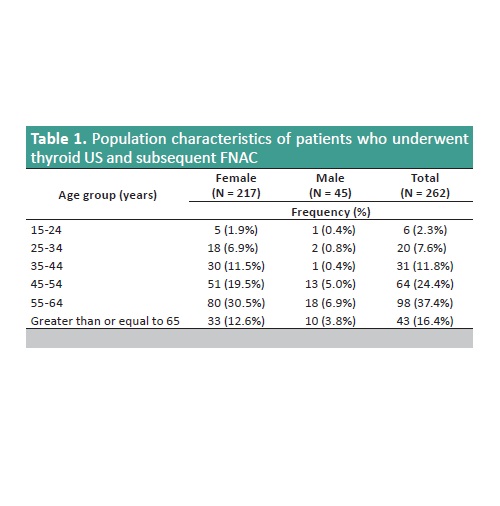Agreement between Sonographic Features and Fine Needle Aspiration Cytology in the Diagnosis of Thyroid Nodules in a Tertiary Hospital
DOI:
https://doi.org/10.21141/PJP2024.06Keywords:
Thyroid nodules, FNAC, TIRADS, UGFNAC, TBSRTCAbstract
Objective. Management of thyroid nodules relies on the Thyroid Imaging Recording and Data System (TIRADS) for sonographic findings and the Bethesda System for Reporting Thyroid Cytopathology (TBSRTC). The proponents aimed to determine the concordance between sonographic TIRADS findings and cytological diagnosis by TBSRTC in the evaluation of malignancy of patients with thyroid nodules.
Methodology. Sonographic and cytology results collected from 2018 to 2022 were obtained to determine whether there is an agreement between TIRADS and TBSRTC findings.
Results. Two hundred sixty-two (262) samples were obtained. Overall accuracy of predicting TIRADS category was highest for echogenic foci. Thyroid nodule distribution was highest for TIRADS 3 and 4 sonographically and TBSRTC II cytologically. There is low agreement between TBSRTC and TIRADS in the categorization of nodules as benign, implying that nodules may show sonographic features suspicious of malignancy despite being categorized as TBSRTC I or II by cytology. However, nodules categorized as TBSRTC III to VI show sonographic features suspicious for malignancy at the very least.
Conclusion. The correctness of TIRADS prediction is highest for echogenic foci although not significantly higher than other parameters. The overall predicting power of TIRADS for the absence of malignancy is high for TIRADS 1 and 2, whereas TIRADS 5 predicts a 31.11% risk of malignancy making it a strong indication for FNAC. However, prediction of malignancy in TIRADS 3 and 4 nodules must be in association with other factors since a significant percentage may turn out to be TBSRTC II.
Downloads
References
American Thyroid Association (ATA) Guidelines Taskforce on Thyroid Nodules and Differentiated Thyroid Cancer 1; Cooper DS, Doherty GM, Haugen BR, et al. Revised American Thyroid Association management guidelines for patients with thyroid nodules and differentiated thyroid cancer. Thyroid. 2009;19(11):1167‑214. https://pubmed.ncbi.nlm.nih.gov/19860577. https://doi.org/10.1089/thy.2009.0110. DOI: https://doi.org/10.1089/thy.2009.0110
Hegedüs L. Clinical practice. The thyroid nodule. N Engl J Med 2004;351(17):1764‑71. https://pubmed.ncbi.nlm.nih.gov/15496625 DOI: 10.1056/NEJMcp031436 DOI: https://doi.org/10.1056/NEJMcp031436
Abelardo AD. Thyroid fine-needle aspiration practice in the Philippines. J Pathol Transl Med. 2017;51(6):555-9. https://pubmed.ncbi.nlm.nih.gov/28994276. https://www.ncbi.nlm.nih.gov/pmc/articles/PMC5700877. https://doi.org/10.4132/jptm.2017.07.14. DOI: https://doi.org/10.4132/jptm.2017.07.14
Kwak J, Han KH, Yoon JH, et al. Thyroid imaging reporting and data system for US features of nodules: a step in establishing better stratification of cancer risk. Radiology 2011;260(3):892‑9. https://pubmed.ncbi.nlm.nih.gov/21771959. https://doi.org/10.1148/radiol.11110206. DOI: https://doi.org/10.1148/radiol.11110206
Paschou SA, Vryonidou A, Goulis DG. Thyroid nodules: a guide to assessment, treatment and follow-up. Maturitas.2 017;96: 1-9. https://pubmed.ncbi.nlm.nih.gov/28041586. https://doi.org/10.1016/j.maturitas.2016.11.002. DOI: https://doi.org/10.1016/j.maturitas.2016.11.002
Tan L, Tan Y S, Tan S. Diagnostic accuracy and ability to reduce unnecessary FNAC: a comparison between four Thyroid Imaging Reporting Data System (TIRADS) versions. Clin Imaging. 2020;65:133-7. https://pubmed.ncbi.nlm.nih.gov/32470834. https://doi.org/10.1016/j.clinimag.2020.04.029. DOI: https://doi.org/10.1016/j.clinimag.2020.04.029
Periakaruppan G, Seshadri KG, Vignesh Krishna GM, Mandava R, Sai VP, Rajendiran S. Correlation between ultrasound-based TIRADS and Bethesda system for reporting thyroid-cytopathology: 2-year experience at a tertiary care center in India. Indian J Endocrinol Metab. 2018;22(5):651-5. https://pubmed.ncbi.nlm.nih.gov/30294576. https://www.ncbi.nlm.nih.gov/pmc/articles/PMC6166562. https://doi.org/10.4103/ijem.IJEM_27_18. DOI: https://doi.org/10.4103/ijem.IJEM_27_18
Ali SZ, Baloch ZW, Cochand-Priollet B, Schmitt FC, Vielh P, VanderLaan PA. The 2023 Bethesda System for reporting thyroid cytopathology. Thyroid. 2023;33(9):1039-44. https://pubmed.ncbi.nlm.nih.gov/37427847. https://doi.org/10.1089/thy.2023.0141. DOI: https://doi.org/10.1089/thy.2023.0141
Chaigneau E, Russ G, Royer B, et al. TIRADS score is of limited clinical value for risk stratification of indeterminate cytological results. Eur J Endocrinol. 2018;179(1):13-20. https://pubmed.ncbi.nlm.nih.gov/29703794. https://doi.org/10.1530/EJE-18-0078. DOI: https://doi.org/10.1530/EJE-18-0078
Alshaikh R, Almaghribi K, Alshammari DM, et al. Correlation between ultrasound and cytological findings of patients with suspicious thyroid nodules: the King Hamad University Hospital experience. Cureus. 2022;14(3): e22877. https://pubmed.ncbi.nlm.nih.gov/35399395. https://www.ncbi.nlm.nih.gov/pmc/articles/PMC8980678. https://doi.org/10.7759/cureus.22877. DOI: https://doi.org/10.7759/cureus.22877
Biswas A, Basu K, De S, et al. Correlation between Thyroid Imaging Reporting and Data System and Bethesda System of reporting of thyroid cytopathology of thyroid nodule: a single center experience. J Cytol. 2020;37(4):193-9. https://pubmed.ncbi.nlm.nih.gov/33776260. https://www.ncbi.nlm.nih.gov/pmc/articles/PMC7984512. https://doi.org/10.4103/JOC.JOC_57_19. DOI: https://doi.org/10.4103/JOC.JOC_57_19

Downloads
Published
How to Cite
Issue
Section
License
Copyright (c) 2024 PJP

This work is licensed under a Creative Commons Attribution-NonCommercial-ShareAlike 4.0 International License.








